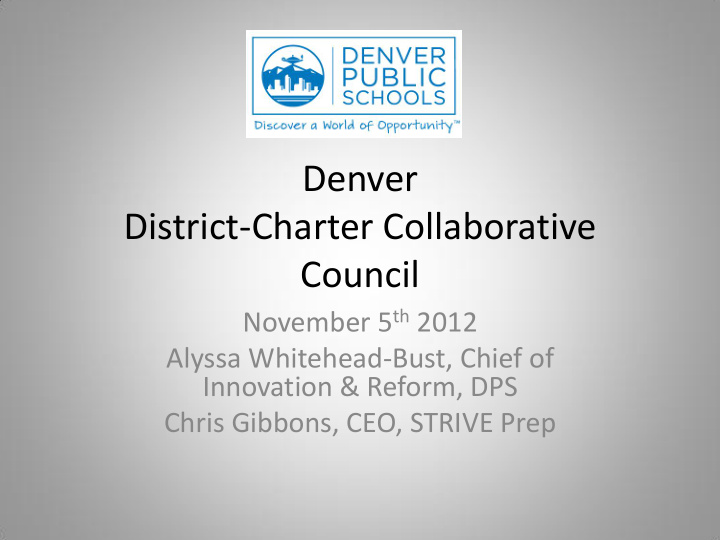



Denver District-Charter Collaborative Council November 5 th 2012 Alyssa Whitehead-Bust, Chief of Innovation & Reform, DPS Chris Gibbons, CEO, STRIVE Prep
Denver’s Three Equities DPS commits to ensuring that all schools – whether district-run or charter – open and operate on the basis of three equities that apply to all our schools: • Equity of opportunity means that the schools have the same access to per pupil dollars, support services from the district, and access to district facilities on the same cost basis. • Equity of responsibility and access means that the schools must offer equitable and open access to all our students — regardless of socio- economic, disability, language or other status — and share an equal burden in district-wide responsibilities such as the cost of pension obligations and district-wide special education funding needs. • Equity of accountability means that all schools have the same accountability system under our School Performance Framework, including charter schools. In the last three years, the District has worked to close or turnaround seven charter schools whose performance has been in the lowest category on the SPF.
Purpose Statement of Collaborative Council (excerpt) The purpose of the Collaborative Council is to discuss and develop policy recommendations to improve the way that Denver Public Schools and its charter schools work together. The Council brings together senior leaders from the district and elected school leaders. Members of the Council are guided by commitments to: • the three equities of opportunity , responsibility and accountability • the value of sharing best practices and collaborating among multiple school types • sustaining charter school autonomy
Context: Enrollment Growth in Charters Charter Enrollment 25,000 20,000 R² = 0.9946 15,325 13,550 15,000 11,780 9,619 10,000 8,546 5,000 - 2010-11 2011-12 2012-13 2013-14 2014-15 (est) (est) Enrollment in charter schools has increased by an average of 20% over the past three years and will reach close to 20,000 students by 2016-17
Context: Count of Charter Schools 2011-12 2012-13 2013-14 31 charters 9,830 39 charters* 11,780 44 charters 13,550** 1 contract 127 1 contract 125 1 contract 125 1 BOCES 400 1 BOCES 400 1 BOCES 400 33 Total: 10,357 41 Total: 12,305 46 Total: 14,075 Opened Aug 2011 Opened Aug 2012 Opening Aug 2013 DSST @ Cole MS DSST @ College View MS Academy 360 KIPP Montbello Monarch Montessori Downtown Denver ES SOAR @ Oakland Rocky Mountain Prep DSST @ Byers MS University Prep Sims-Fayola Highline Academy #2 STRIVE Montbello STRIVE HS NW STRIVE GVR STRIVE HS SW Closed at EOY Manny Martinez 118 Closed at EOY Closed at EOY Life Skills 222 TBD TBD *Also added two DSST’s and one Venture Prep by virtue of splitting HS/MS into separate campuses. **Very rough estimate (real projections come out in Dec 2012).
Context: Equity of Students Served 2011-12 Student Demographics 80% 70% 60% 50% Charter 40% District 30% 20% 10% 0% % FRL % ELL % SPED Charter students are generally similar in demographic data to the overall district – with higher percentages of FRL students in charters.
Context: Charter Performance as Compared to District % of Charter Students Attending % of Students Attending Schools by SPF Ratings Traditional District-run Schools by SPF Ratings 13% 5% 11% 20% 6% 1% 17% 45% 0% 0% 7% 32% 42% Distinguished on track to distinguished Distinguished Meets Expectations Meets Expectations on track to meets Accredited On Watch Accredited On Priority Watch Accredited On Watch on track to on watch Accredited On Probation Accredited On Priority Watch Accredited On Probation A significantly higher portion of students in charters (20%) are attending schools that are Distinguished on the SPF, as compared to students in District-run schools (5%). However, the same applies for the lowest two rankings (Accredited on Priority Watch & Probation).
Median Growth Percentile (MGP) on TCAP (standardized test) • All school types showed greater than expected growth in all subjects in 2012. • Charter schools outperformed innovation and traditional schools in MGP for all subjects in 2012. • Innovation schools nearly matched traditional schools’ MGP in Reading and Writing. 8
Evolution in Collaboration District Charter Collaborative Council Compact Blue & Compact (Dec 2010) (Dec 2011) Ongoing Collaboration The Collaborative Council is an evolution in our approach to district-charter collaboration that began to take shape with the first Gates Compact and has continued to develop so that best practices are disseminated district-wide.
Structure of Collaborative Council Board of Education Superintendent Collaborative Council Charter Co-Chair District Co-Chair Four District Representatives from Four Elected Charter the Senior Leadership Representatives and Team, including the one Appointed Charter Chief of Innovation & Representative Reform Working Groups Special Alternative Serving OSRI Finance Education Education ELLs Advisory
Reflection: First 6 Months – Helping/ Hindering Us to Achieve Purpose Helping Hindering • Composition of Group • Broader Stakeholder Involvement & Engagement • Communication • Time • Purpose • Translation of Policy to • Group Norms Action • Prioritization
Looking Forward: Collaborative Council Priorities for 12-13 • Create, monitor, and improve policies that impact DPS and charters • Help direct and monitor and provide feedback on Working Group priorities • Creating and leveraging a meaningful connection to the superintendent and the board
Recommend
More recommend